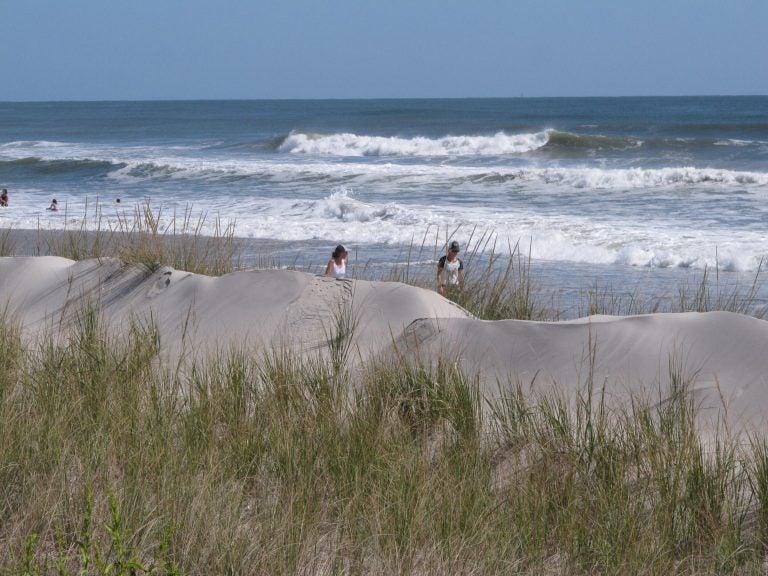A little off the top: N.J. may rearrange some ocean dunes
New Jersey may take the unusual step of trimming some large dunes and using the sand to widen the beach in front of them.

This Sept. 20, 2019 photo shows some of the sand dunes in Stone Harbor, N.J. (Wayne Parry/AP Photo)
New Jersey, which has waged relentless court battles to build protective sand dunes along its coast, may take the unusual step of trimming some large dunes and using the sand to widen the beach in front of them.
The proposal would appear to fly in the face of strenuous and costly efforts to ensure dunes are in place along most of the state’s 127-mile coastline. That included court cases against dune opponents and people seeking financial compensation for the loss of oceanfront property and ocean views.
But a special set of circumstances, including robust dunes that are considerably larger than minimum standards, and a federal policy placing a traditional sand pumping site off-limits to federally funded projects, has led U.S. and state authorities to consider “harvesting” sand from some dunes in Stone Harbor.
Sand removed from the top and sides of those dunes, some of which are 10 feet or more higher than minimum standards, would be used to widen the beach in badly eroded areas where there is little beach left between the water and the dunes.
“One of the benefits of this approach, if used, would be to manage sand on the beaches and dunes without having to take sand from offshore,” said Larry Hajna, a spokesman for the state Department of Environmental Protection.
Stephen Rochette, an Army Corps spokesman, said he is not aware of the tactic having been used before in New Jersey. A decision by state and federal agencies on whether to proceed could be made within two weeks after studying the dunes that would be affected.
It is being considered because a site in the Hereford Inlet, which was previously used to dredge sand for beach replenishment projects in the area, has been put off-limits for such a federally funded project by the U.S. Fish & Wildlife Service. The agency acted recently under a 1982 law passed by Congress to preserve coastal barrier regions from overdevelopment and barring the use of federal funds for work that could contribute to such development.
The Fish & Wildlife Service said Friday that “certain actions and programs of the Federal government had the effect of encouraging development of fragile, high-risk, and ecologically sensitive coastal barriers.”
It said the law does not allow for sand mining in the Hereford Inlet for projects outside the area, as would be the case with Stone Harbor.
The agency issued a similar opinion to the Army Corps in 2016.
Affected towns including Stone Harbor and Avalon have threatened litigation over the restriction. Stone Harbor’s mayor and three council members on its beach committee did not respond to requests for comment.
“The federal project is without a sand source for Stone Harbor going forward,” said Stewart Farrell, director of Stockton University’s Coastal Research Center and a leading expert on New Jersey beaches. “Offshore supplies are perhaps five years away if done fast; that never happens.”
The “harvesting” plan is an option in the latest contract for beach replenishment in Stone Harbor, a tony seaside town just north of Wildwood, where years of natural accretion has built up sand dunes far in excess of those in some other areas.
In the area envisioned for sand borrowing, the dunes consist of several rows of sand bumps, covered with dense vegetation including dune grass, shrubs and trees that help trap and retain sand.
In some spots, the dunes take up half of the beach or more, Farrell said. That leaves plenty of margin for part of their sand to be removed and spread out in front of them to widen the beach.
Tim Dillingham, executive director of the American Littoral Society, called the dune-trimming plan a better option than using sand pumped from offshore.
“The Army Corps views it as ‘excess’ since it is beyond their design profiles,” he said. “Harvesting and placing in front, on the beach, maintains the risk reduction design the project started with. It doesn’t create more vulnerability, and it takes the project back to its starting profiles.”
WHYY is your source for fact-based, in-depth journalism and information. As a nonprofit organization, we rely on financial support from readers like you. Please give today.




